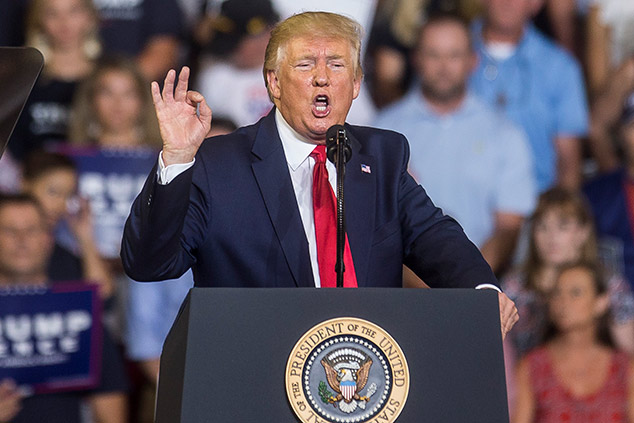
This article is taken from our FREE daily investment email Money Morning.
Every day, MoneyWeek’s executive editor John Stepek and guest contributors explain how current economic and political developments are affecting the markets and your wealth, and give you pointers on how you can profit.
A quick one before I start this morning – how confident are you that you’ll have enough money during your retirement years? If you’d like to learn more about how to build a wealth plan that you can have confidence in, then you should head along to our evening event (in association with The Week and Netwealth) on 9 October. You can find out more about it here, but hurry – the tickets for these tend to sell out fast.
There has been “no change” to the US government’s policy towards the US dollar, US Treasury Secretary Steven Mnuchin said yesterday.
We all know that you should never believe anything until it’s been officially denied.
And Mnuchin qualified his answer with “as of now”, which we also know means that it could change “as of the next ten minutes”.
But that raises a few questions – what is the current US dollar policy anyway, how might it change, and what would that mean for us as investors?
Why Trump wants a weaker dollar
In recent history, the US has favoured a “strong dollar policy”. In practice, that doesn’t mean anything. When you say you want a strong dollar, then it protects you from a lot of arguments.
If the dollar is weak and other countries complain, you shrug and say: “Hey, we want a strong dollar. But we also respect free markets.”
And if other countries (allies like Japan or the eurozone) are trying to bail out their economies by weakening their currencies, then that’s fine too. “We don’t mind, we have a strong dollar policy anyway.”
So it’s a useful fig leaf. Like so many things in politics, it’s about plausible deniability. It’s about being able to say one thing, and do another, without anyone losing too much face.
Since Donald Trump took over, the politically inexperienced Mnuchin has occasionally made the mistake of saying what he actually thinks about the US dollar, which is effectively that it should find whatever level makes sense. So not strong, nor weak, just whatever the market says.
Meanwhile, Trump, who is not a massive fan of fig leafs or diplomacy, but does rather like rising stockmarkets and low interest rates, has been loudly and regularly proclaiming that what he really, really wants is a weak dollar.
Why does he want a weak dollar? Mainly because a weak dollar tends to mean the stockmarket goes up. There are a few reasons for that.
Firstly, a weak US dollar means looser global monetary policy. Almost everyone on the planet needs dollars, so when they’re cheap, monetary conditions are easier for everyone.
Secondly, a weak US dollar boosts earnings for companies selling goods and services overseas. Given the the S&P 500 earns a great deal of money outside the US, that’s good for US stocks.
Thirdly, a weak US dollar should spur inflation in the US. Inflation eats away at debt. And the US has quite a lot of that (although it’s hardly unique in that state of affairs).
But mostly, Trump cares about the rising stockmarket, and he has a rough idea of what button you need to press to make that more likely.
So the big question is: can he do anything about this, beyond ranting?
How the US could target the dollar
The answer is “yes”. The Federal Reserve, America’s central bank, has already made it pretty clear that it will cut interest rates – however strong the economic data – at the end of this month. And yet the dollar has remained stubbornly strong – it’s certainly eased off a bit since early June, but it’s by no means weak.
But if the president genuinely wants to whack the dollar, he does have the tools with which to do it. And as Steven Englander of Standard Chartered tells the FT, now that Mnuchin has spoken, “the door is somewhat more wide open than ever before for intervention.”
So how would that work? In short, the US Treasury Department would just sell dollars. It’s that simple. It doesn’t need the co-operation of the Fed (indeed, in the late 1980s, the Fed and the Treasury clashed over the latter’s interventions in the currency market, notes the FT), but it would probably get it, for the sake of keeping the peace if nothing else.
Would it succeed? It really depends on how other countries respond. Most pundits reckon it wouldn’t, because you’d get tit-for-tat responses. But then where would we go from there? If the European Central Bank intervenes, do you get tariffs on German cars? If China intervenes, what happens then?
So it could get messy. At the same time, I can’t see Trump giving up. So what’s the most likely option?
I’m not sure, but I do think that a weaker dollar is on the cards. And it strikes me that the easiest way to get it is for the Fed to be even more dovish than anyone expects. That’s quite tricky at the moment, but it would boil down to a half-point cut, rather than a quarter-point, at the end of this month.
I think that would be hard for the market to ignore, and it would also side-step the tricky question of currency manipulation.
But if that doesn’t happen, then I don’t think Trump will shut up, particularly if it looks as though a strong dollar might jeopardise the stockmarket run. Instead, I’d expect him to go down the messier route, to see where it leads.
We wrote about the forces quietly undermining the dollar a couple of months ago. But in all, I’m not surprised that gold is doing well right now.